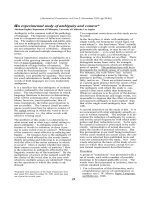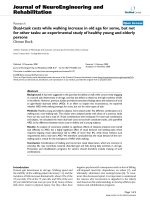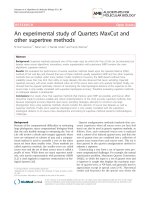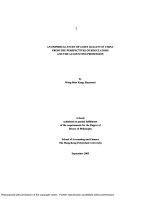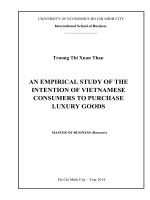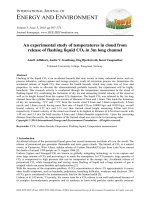An experimental study of video uploading from mobile devices with HTTP streaming
Bạn đang xem bản rút gọn của tài liệu. Xem và tải ngay bản đầy đủ của tài liệu tại đây (1.84 MB, 81 trang )
AN EXPERIMENTAL STUDY OF VIDEO
UPLOADING FROM MOBILE DEVICES
WITH HTTP STREAMING
CUI WEIWEI
NATIONAL UNIVERSITY OF SINGAPORE
2012
AN EXPERIMENTAL STUDY OF VIDEO
UPLOADING FROM MOBILE DEVICES
WITH HTTP STREAMING
CUI WEIWEI
(B.Sc., Harbin Institute of Technology, China)
A THESIS SUBMITTED FOR THE DEGREE OF
MASTER OF SCIENCE
SCHOOL OF COMPUTING
NATIONAL UNIVERSITY OF SINGAPORE
2012
Declaration
I hereby declare that the thesis is my original work and it has been written by me
in its entirely. I have duly acknowledged all the sources of information which have
been used in the thesis.
This thesis has also not been submitted for any degree in any university
previously.
Cui Weiwei
27 July 2012
Abstract
Mobile video traffic is growing rapidly in networks due to the continuing
user adoption of smartphones and tablet computers. While video viewing is now
prevalent on such devices, they also easily enable the recording and uploading of
videos for quick publishing on popular video sharing websites. However, due to
the nature of the shared wireless network, such as repeatedly dropped connections,
significantly fluctuating transmission speeds, and restricted bandwidth usage, uploading videos directly from mobile devices, which frequently results in unacceptable
end-to-end user experiences, has not been widely used yet. In this thesis, we examine the common challenges during the client-to-server uploading of mobile videos
and propose a new approach that provides compatibility with the Dynamic Adaptive Streaming over HTTP (DASH) standard [6] and at the same time improves
content availability by reducing the end-to-end delay from the recording time of
mobile videos to the publishing of the multi-bitrate encoded versions through a
careful pipelining of the overall process. Our approach features (1) the use of segmentation of videos on the mobile devices before uploading and (2) segment-wise
transcoding and transformatting on the server-side. To test the performance of our
approach, we built a test-bed environment which consists of three components: a
mobile uploader, a video hosting server and a mobile player, and implemented the
proposed approach on two dominate mobile platforms (Android and iOS) for both
stored and live videos. The experiment was performed on real mobile devices: three
Android mobile devices and an iPhone 4. The experimental results show that our
approach reduces the end-to-end startup latency significantly and provides users a
better video streaming experience without any additional hardware requirements.
Acknowledgments
First, I would like to express my deepest gratitude to my supervisor, Professor Roger Zimmermann, for his guidance and support. Throughout my master
study, he has been inspiring me in the right research direction when I felt confused
and encouraging me when I got frustrated. It is my great honor to be one of his
students.
Second, I would like to thank Dr. Beomjoo Seo, a research fellow of my
supervisor, for his sound advice and patient instruction. It was nice to cooperate
with him.
Third, I would like to thank my labmates, for their caring, support and the
happy life we have spent together in the last two years.
Finally, I would like to thank my parents, for their understanding and endless
love.
1
Contents
Summary
i
List of Tables
ii
List of Figures
iii
List of Abbreviations
v
Chapter 1 Introduction
1
1.1 Motivation . . . . . . . . . . . . . . . . . . . . . . . . . . . . . . . .
1
1.2 Research Challenges . . . . . . . . . . . . . . . . . . . . . . . . . .
3
1.3 Thesis Contribution . . . . . . . . . . . . . . . . . . . . . . . . . . .
6
1.4 Thesis Organization . . . . . . . . . . . . . . . . . . . . . . . . . . .
6
Chapter 2 Background and Literature Survey
2.1 Media Streaming over the Internet . . . . . . . . . . . . . . . . . .
8
9
2.1.1
Push-Based Media Streaming . . . . . . . . . . . . . . . . .
9
2.1.2
Pull-Based Media Streaming . . . . . . . . . . . . . . . . . .
10
2.1.3
Dynamic Adaptive Streaming over HTTP . . . . . . . . . .
12
2.1.4
Summary . . . . . . . . . . . . . . . . . . . . . . . . . . . .
18
2.2 Quality Adaptation Algorithms in DASH . . . . . . . . . . . . . . .
19
2.2.1
Single-layer Quality Adaption Algorithms . . . . . . . . . .
2
19
2.2.2
SVC-based Quality Adaptation Algorithms . . . . . . . . . .
24
2.2.3
Summary . . . . . . . . . . . . . . . . . . . . . . . . . . . .
26
Chapter 3 Proposed Approach
27
3.1 System Design . . . . . . . . . . . . . . . . . . . . . . . . . . . . . .
27
3.2 Segmentation at the Mobile Client for Stored Videos . . . . . . . .
30
3.2.1
On-the-fly Segmentation . . . . . . . . . . . . . . . . . . . .
30
3.2.2
Delivery Format Selection . . . . . . . . . . . . . . . . . . .
32
3.2.3
HTTP-based Segment-level Resumable Upload . . . . . . . .
33
3.3 Server-side Post-processing . . . . . . . . . . . . . . . . . . . . . . .
34
3.3.1
Segment-level Transcoding . . . . . . . . . . . . . . . . . . .
3.3.2
DASH-compatible Playlist Preparation, Publishing and Update 35
3.3.3
Gearman-based background processing . . . . . . . . . . . .
3.4 Live Recording and Live Segmentation at the Mobile Client
. . . .
Chapter 4 Experimental Evaluations
34
35
37
42
4.1 Dataset Description and System Parameters . . . . . . . . . . . . .
42
4.2 Evaluation Metrics . . . . . . . . . . . . . . . . . . . . . . . . . . .
44
4.3 Experimental Results and Analysis . . . . . . . . . . . . . . . . . .
46
4.3.1
Segmentation Overhead . . . . . . . . . . . . . . . . . . . .
46
4.3.2
WiFi Transmission Delay . . . . . . . . . . . . . . . . . . . .
51
4.3.3
Transcoding Delay . . . . . . . . . . . . . . . . . . . . . . .
53
4.3.4
Putting It All Together: Startup Latency . . . . . . . . . . .
55
4.3.5
Live Segmentation Latency . . . . . . . . . . . . . . . . . . .
60
Chapter 5 Conclusions and Future Work
3
64
Summary
The primary objective of this thesis is to present our proposed segmentwise video uploading approach, which aims to be DASH-compliant, while reducing
the end-to-end startup latency from the recording time of mobile videos to the
final playback of the multi-encoded versions on other mobile devices. As video
viewing on mobile devices such as smartphones or tablet computers is prevalent
now along with the ability of video recording and uploading directly from these
mobile devices via wireless networks to allow quick publishing on popular video
sharing websites, making the overall processes smooth and efficient which is an
important topic of media streaming on mobile devices. Our main work focuses
on uploading mobile videos efficiently via wireless network1 , and minimizing the
overall startup latency. Therefore, in this thesis, we first examine the common
challenges during the uploading of mobile videos, then we propose a new approach
that segments the video on mobile client-side before uploading, and does segmentwise transcoding and transformating on the server-side. To test the performance
of our approach, we built a test-bed environment, implemented the approach on
two dominate mobile platforms (Android and iOS), and did experiments on real
mobile devices: three Android mobile devices and an iPhone 4, with pre-recorded
videos and live-recorded videos respectively. The experimental results show that
our approach reduces the startup latency significantly, and is practically realizable
for both pre-recorded and live-recorded videos.
1
The wireless here refers to WiFi only as the test was conducted in WiFi paradigm not 3G/4G.
i
List of Tables
4.1 Video characteristics of the source streams used for the experiments,
recorded on Android devices. . . . . . . . . . . . . . . . . . . . . . .
44
4.2 Normalized median segmentation time (processing time / segment
duration) for three mobile Android devices and one iOS device.
Values less than 1 indicate that the segmentation process can be
pipelined in a continuous, uninterrupted manner. . . . . . . . . . .
48
4.3 The normalized average transcoding time of two sets of video segments for two types of videos (480p and 720p). HIGH represents
video with a 640×480 resolution at 2 Mbps; MEDIUM, 480×360 at
768 Kbps; and LOW, 320×240 at 256 Kbps. Due to our implementation limitation, our hosting system contained a mix of 720×480 and
640×480 videos. To avoid confusion, we chose the source quality of
480p video as 720×480 and the target transcoded quality of 480p
video as 640×480. . . . . . . . . . . . . . . . . . . . . . . . . . . . .
55
4.4 Ten sampled, normalized startup latencies and their component delays for 10-second segment durations of 480p video. . . . . . . . . .
57
4.5 Ten sampled, normalized startup latencies and their component delays for 10-second duration of live segmentation. . . . . . . . . . . .
ii
61
List of Figures
1.1 Mobile video will generate over 70 percent of mobile data traffic by
2016 [16] . . . . . . . . . . . . . . . . . . . . . . . . . . . . . . . . .
2
3.1 DASH-aware uploading architecture. It features on-the-fly segmentation at the mobile client and server-side segment-level transcoding. 28
3.2 Top level m3u8 playlist example . . . . . . . . . . . . . . . . . . . .
36
3.3 Low bitrate m3u8 playlist example . . . . . . . . . . . . . . . . . .
36
3.4 Flowchart of live recording and live segmentation on iOS device . .
39
4.1 Components of our video streaming test-bed . . . . . . . . . . . . .
43
4.2 Illustration of the different delay components and their relationships. 46
4.3 Two segmentation processing metrics – (a) the ratio of the static
(fixed) portion to Tseg and (b) the copy efficiency, denoted by the
total number of bytes over the total copy duration – are plotted as
a function of the segment duration for 480p video. Measurements
were obtained from a Droid phone. . . . . . . . . . . . . . . . . . .
48
4.4 The normalized segmentation delay of 720p video on the iPhone 4 is
plotted as a function of the segment duration. . . . . . . . . . . . .
50
4.5 The normalized WiFi transmission delays of all video segments are
drawn as box plots. Values less than 1 indicate that uninterrupted
streaming is possible. . . . . . . . . . . . . . . . . . . . . . . . . . .
iii
52
4.6 The final normalized startup delays for stored video plotted as a
function of the segment duration. . . . . . . . . . . . . . . . . . . .
59
4.7 The final normalized startup delays for live-recorded video plotted
as a function of the segment duration.
iv
. . . . . . . . . . . . . . . .
63
List of Abbreviations
DASH
Dynamic Adaptive Streaming of HTTP
TS
Transport Stream
RTSP
Real-time Streaming Protocol
NAT
Network Address Translation
GOP
Group of Picture
HLS
HTTP Live Streaming
HDS
HTTP Dynamic Streaming
RTMP Real Time Messaging Protocol
AVC
Advanced Video Coding
SVC
Scalable Video Coding
OSMF
Open Source Media Framework
CBR
Constant Bit Rate
MDP
Markov Decision Process
NTP
Network Time Protocol
v
Chapter 1
Introduction
1.1
Motivation
With the expansion in 3G/4G cellular coverage, wider availability of WiFi connectivity, and the emergence of more powerful and intelligent mobile devices, video
streaming over the Internet to wireless mobile devices has seen a tremendous increase in popularity amongst users and mobile video traffic is growing rapidly correspondingly. Mobile data traffic, according to an annual report from Cisco [16],
continues to grow higher than estimated due to the continuing user adoption of
smartphones and tablet computers. Figure 1.1 shows that mobile video traffic –
already consisting of half of the total mobile network traffic – will account for
three-fours by 2016. However, since mobile devices are diverse in capacity and
have different screen sizes, computation power, battery amounts and available network bandwidth, it is considerably challenging to stream videos to those wireless
connected mobile devices, and at the same time, meet the users’ demand for highquality video experience in terms of video quality, video delivery efficiency, start-up
latency, scalability and so on. Therefore, new technologies are required to improve
the video streaming experience and provide users with a satisfactory quality of
1
Figure 1.1: Mobile video will generate over 70 percent of mobile data traffic by
2016 [16]
experience.
The Dynamic Adaptive Streaming over HTTP (DASH) standard [6], which
is a new video delivery mechanism based on HTTP progressive download, has recently been adopted and gained attention for its ability to enable media players to
render videos with high quality under various network conditions. Its main features
are (1) splitting a large video file into a series of smaller pieces (called segments),
(2) providing flexible bandwidth adaptation by enabling stream switching among
differently encoded segments, and (3) hosting near-live streaming events. The delivery format of a segment can be either an ISO-based file format or an MPEG-2
Transport Stream [13]. Because DASH utilizes the HTTP protocol it is more widely
compatible with network firewalls as compared with traditional RTSP/RTP-based
streaming solutions [23]. Furthermore, it has a lower bandwidth overhead than
HTTP progressive streaming, using existing content distribution and delivery networks.
2
The DASH standard, however, primarily focuses on server-to-client distribution of videos and assumes that the original video files in their multiple encoded
versions already exist and are available during the segmentation – typically at the
server-side via some off-line mechanisms. Little consideration has been given to the
case when users desire to upload a video from his or her mobile device directly for
a quick publishing on some popular video sharing websites, which may frequently
result in unacceptable end-to-end user experiences. The following sample scenario
exemplifies such a prototypical case:
A user, recently having shot a video, uploads it from his mobile phone
to share with his friends. Soon after initiating the video upload from his
phone, however, he encounters strange problems: frequent connection
drops and wildly fluctuating transmission delays (due to the shared
nature of the limited wireless spectrum). He eventually decides not to
upload the video from the phone, but to copy it to a wired desktop PC
and submit it from there. With all these obstacles he finally succeeds
in uploading the video, but still must wait until all the post-processing,
such as keyword extraction and transcoding, is completed, and he might
forget to send the link to his friends after all is done.
This scenario highlights several notable issues of mobile video uploading
which will be discussed in details in the following section.
1.2
Research Challenges
Several notable issues are apparent from the above scenario:
First, uploading a large video file via a wireless network is still subject to
various networking problems such as repeatedly dropped connections caused by
wireless interference and significantly fluctuating transmission speeds during busy
3
times. These conditions are primarily caused by the nature of the shared wireless
environment. Some users also have wireless plans that cap their bandwidth usage.
Due to these issues, mobile video uploading has not been very widely used yet.
For example, only a small fraction of all YouTube videos have been uploaded from
mobile devices. We were unable to find any publicly available statistics on this
topic, so we collected the following information to infer mobile usage: 48 hours of
videos are uploaded on YouTube every minute [31], but less than 30,000 videos (we
observed at most 27,900 as of the third week of September 2011) are uploaded every
week from Android smartphones1 , and the average length of YouTube videos is 210
seconds [14]2 . Using these statistics, we estimate that 0.34 percent3 of the total
number of uploaded videos comes from Android mobile devices. Considering that
users prefer to record high resolution videos – e.g., encoded at 720p – on their phones
without much contemplation for the required wireless bandwidth, video uploads
from mobile devices will continue to encounter a significant network bottleneck in
the foreseeable future.
Second, even when users are successful in uploading videos via a wireless
network, the server-side post-processing to prepare multiple versions of the videos
encoded at different bitrates prohibits an immediate availability of the content.
Multi-bitrate videos are crucial component of adaptive streaming. If transcoding is
performed at the server side on the full length of a video, then the uploading process
must complete first before transcoding into a variety of different encoding rates
can be initiated. Current streaming solutions assumes that the multiple encoded
1
We searched for the keyword phrase “uploaded from” which is automatically inserted during
video sharing by many off-the-shelf Android camera applications. We excluded irrelevant results
manually.
2
This statistic may be somewhat out-dated, but we believe that the correct value is still in the
range between 3 and 4 minutes.
3
Although this number may not reflect the exact value, it would seem to support the assertion
that mobile video uploading is not a mainstream activity yet.
4
versions of the original video file already exist and have been prepared via off-line
mechanisms, while little attention has been paid to the case of on-line transcoding
which requires lengthy time on a full video file.
Third, from the time of recording of the video content to the final playback
via web interface, a lengthy waiting time is required for the whole processing procedures to be completed. The end-to-end delay not only depends on the unstable
wireless network conditions and uplink bandwidth limitations, but also increases
with regard to the length of the video file. As far as we know, there has been little
attention paid to minimize this end-to-end delay and no consideration has been
given to the case of uploading user generated video content directly from mobile
devices and making it available as soon as possible through video hosting services,
which is challenging but a practical problem that is in much need to be solved.
Below are the typical requirements of a mobile user for this type of application
environment:
• Users prefer uploading the highest video quality available from their mobile
devices, regardless of their wireless environment.
• Users expect their uploaded videos to be available immediately after they
upload them.
• Users also expect to watch videos at high quality, despite a limited wireless
capacity in their environment.
To address these aforementioned issues and meet users’ demanding requirements at the same time, we propose a new mobile video uploading solution in
this thesis that aims to minimize the startup latency and achieve semi-realtime
streaming for stored videos and realtime streaming for live recording videos.
5
1.3
Thesis Contribution
The main contributions of this thesis can be summarized as follows:
• Firstly, we propose a mobile video uploading solution which intentionally
places the segmentation at the mobile client-side to improve the robustness of
video upload, and does segment-wise transcoding on the server-side to provide
quick availability of video content. We carefully arranges the end-to-end software components both at server- and client-side to allow efficient, pipelined
processing and supporting the aforementioned user requirements (high quality uploading, fast content availability, good video viewing experience) at the
same time.
• Secondly, we design our streaming system to be compatible with the DASH
standard that has recently been adopted for its ability to enable media players
to smartly select video clips under various network conditions, thus it can
provide users with a good video viewing experience with various devices via
various network accesses.
• Thirdly, we develop a video streaming system which consists of three primary software components: a mobile uploader, a video hosting server and
a mobile player. We implemented our approach on two dominate mobile
platforms (Android and iOS) for both stored and live recorded videos and
perform experiments on real mobile devices in real environments, to test the
practicability and feasibility of our proposed approach.
1.4
Thesis Organization
The rest of this thesis is organized as follows.
6
Chapter 2 Background and Literature Survey describes an overview
of media streaming protocols over the Internet first, then gives an introduction
of the DASH standard, providing some background knowledge, and provides a
comprehensive literature survey on quality adaptation algorithms in DASH systems.
Chapter 3 Proposed Approach presents our proposed approach in details, including both the client-side segmentation algorithms and server-side postprocessing methods, and the different implementation mechanisms for stored videos
and live recorded videos as well.
Chapter 4 Experimental Evaluation reports on the evaluation results of
our prototype system built on top of our test-bed, discusses and analyzes several
types of overhead and delays, and its practical applicability in real environment.
Chapter 5 Conclusions summarizes our work.
7
Chapter 2
Background and Literature
Survey
On the issue of mobile uploading, there exists not much literature work. As our solution aims to reduce the video streaming startup latency and provide compatibility
with the DASH standard, we will undertake a background study of video streaming
concepts and a brief introduction to the DASH standard first, then give a general
overview of other related research work. The subsequent parts of this chapter are
organized as follows. Section 2.1 reviews the basic concepts of media streaming over
the Internet, associated with corresponding streaming protocols, then introduces
the background knowledge of the DASH standard, a newly adopted HTTP-based
media delivery mechanism, and briefly reviews several popular, commercial HTTP
streaming solutions. Since the DASH standard mainly focuses on delivering the
best adaptive media streaming across diverse devices under various network conditions, a brief survey of DASH-related rate adaptive algorithms will be given in
section 2.2.
8
2.1
Media Streaming over the Internet
Today, media content has become a major part on the Web. News clips, full-length
movies, TV shows, and videos made and shared by common people are watched
by millions of people everyday over the Internet. A number of media streaming
methods are available in the classic client-server architecture, and they can be
classified into two main categories: push-based and pull-based streaming methods
[9].
2.1.1
Push-Based Media Streaming
The main characteristic of a push-based system is that it is the server that pushes
the data to the client - the client is just waiting for the data. Therefore, the
scheduling is done at the server side. Once a connection is established between
a server and a client, the server is always on and streams packets to the client
until the session is torn down or interrupted by the client. Consequently, in pushbased streaming, the server maintains a connection state with the client and listens
for commands sent by the client regarding session state changes. The Real-time
Streaming Protocol (RTSP) [3], specified in RFC 2326, is one of the most common
session control protocols used in push-based streaming.
In RTSP, a specialized streaming server is required which breaks the media
resource into small packets according to the bandwidth available between client and
server and then sends the packets after the client requests to watch the video. As
long as enough packets have been received, the client can start to play these video
packets and keeps downloading the successive ones. This enables the client to view
the video in real-time without having to download the entire media file. During
the session, the server is available and the client can communicate with the server
and send commands such as fast-forward seek/play or rewind. The server responds
9
according to the client’s state information and can also send requests to a client,
for example, the server can send requests to set client-side playback parameters of
the stream, which is unlike HTTP where only the client can send requests and the
server responds correspondingly.
Advantages of real-time streaming in comparison to HTTP download are
the low latency (the media player is able to start immediately), the efficient use
of bandwidth (the multimedia content does not have to be stored on the client),
and the possibility on the server to monitor exactly the watching behavior of the
clients. However, real-time streaming also comes with disadvantages. One is that
a specialized streaming server is required to respond to client’s commands and
keeping client’s state during the session also comes with a high cost. Furthermore,
real-time streaming packets are usually transmitted over UDP and these packets
can be blocked by many firewalls, making it difficult to deliver streams reliably.
2.1.2
Pull-Based Media Streaming
In pull-based streaming methods, the media client is the active entity that requests
the content from the media server. Therefore, the server response depends on
the client’s requests where the server is otherwise idle or blocked for that client.
It is stateless and the server does not keep the client’s state after the response.
Consequently, the bitrate at which the client receives the content is dependent upon
the client and the available network bandwidth. As the primary download protocol
of the Internet, HTTP is a common communication protocol that pull-based media
delivery is based on.
HTTP Progressive download or pseudo-streaming [18] is one of the most
widely used pull-based media streaming methods available on IP networks today.
In progressive download, the media client issues an HTTP request to the server
and starts pulling the content from the server as fast as possible. Once a minimum
10
required buffer level is obtained, the client starts playing the media while at the
same time it continues to download the content from the server in the background
(in contrast to the traditional HTTP download in which the user has to wait until
the whole media file is downloaded). As long as the download rate is not smaller
than the playback rate, the client buffer is kept at a sufficient level to continue the
playback without any interruption. However, if the network conditions degrade, the
download rate may fall behind the playback rate and eventually a buffer underflow
may result.
Unlike a streaming server in real time streaming that sends a small duration
of media data (rarely more than 10 seconds) to the client at a time, a HTTP Web
servers keep the data flowing until the download is completed. If the client pauses
a progressively downloaded video at the beginning of playback and then waits, the
entire video will eventually be downloaded to the client’s browser cache, allowing
the client to smoothly play the whole video without any hiccups. This behavior,
however, has a downside as well. If the client turns off the video player or switches
to another video while downloading is still in progress, a large amount of un-wanted
video is buffered unnecessarily, which wastes the bandwidth of both the network
and the end-systems.
The main advantage of pull-based steaming over push-based streaming method
is that it is the client that requests the video data and manages the bitrate, which
significantly simplifies the server implementation. As it runs on HTTP over TCP,
an ordinary Web server can be used as the video hosting server, and it can utilize
existing CDN networks and cache architectures, which further makes it more cost
effective.
11
2.1.3
Dynamic Adaptive Streaming over HTTP
In the streaming media industry, HTTP-based media delivery has emerged as a
de-facto streaming standard over recent years, replacing the existing media transport protocols such as push-based RTP/RTSP. Although the conventional wisdom
holds that video streaming would never work well over HTTP which uses TCP as
transport protocol, due to the throughput variations caused by TCP’s congestion
control and the potentially large retransmission delays, several work [19] [20] have
shown that TCP can be used for streaming as well, in contrast to the traditional
view that UDP should be used for streaming media applications. In practice, two
points became quite clear in the last few years. First, TCP’s congestion control
mechanisms and reliability requirement do not necessarily hurt the performance of
video streaming, especially if the video player is able to adapt to large throughput variations. Second, the use of HTTP over TCP in practice greatly simplifies
the traversal of firewalls and Network Address Translations (NATs), and can reach
a wide audience due to its high network penetrability and excellent match with
existing HTTP-based caching infrastructures.
Dynamic Adaptive Streaming over HTTP (DASH) is a newly adopted media
delivery method and has gained great attention recently. It is a hybrid delivery
method that acts like streaming but is based on HTTP progressive download. The
main features of this technique are (1) splitting an original encoded video into
small pieces of self-contained media fragments, or segments, (2) providing flexible
bandwidth adaptation by enabling stream switching among differently encoded
segments, and (3) hosting near-live streaming events.
In DASH, the server maintains multiple profiles of the same video, encoded
in different bit rates, corresponding to different resolutions and quality levels. The
video object is partitioned in segments, typically a few seconds long, split by Group
of Pictures (GOP) [1] boundaries. This means that each segment is self-contained
12
and has no dependencies on other segments, so that each can be decoded independently. A player (at the client side) can then request different segments at different
encoding bit rates, depending on the underlying network conditions and CPU capabilities. This adaptive mechanism provides users with the best quality of experience
in terms of (1) highest achievable quality, because the player can request the best
bit rate video segment based on the available bandwidth; (2) faster start-up and
quicker seek time, because start-up can be initiated on the lowest bit rate before
moving to a higher bit rate; (3) reliable, consistent and smooth playback without
stutter, buffering or “last mile” congestion, because a client can dynamically adapt
to the inferior network conditions and switch to download the most appropriate bit
rate segments.
Since DASH is pull-based it uses HTTP, in contrast to traditional real-time
streaming where the streaming server controls the speed of sending data packets
(the media is pushed to the client). In DASH, it is the client that decides what
best bit rate to request for any segment, and the segments can further be cached
by browsers, proxies, and CDNs, which can drastically reduce the load on the
source server and improve server-side scalability. Another benefit of this approach
is that the client can control its playback buffer size by dynamically adjusting the
rate at which the new segments are requested and hence it is fully customizable.
Furthermore, as DASH uses HTTP, it also inherits all the advantages that HTTP
has over traditional streaming methods.
Different types of HTTP streaming solutions have been proposed in the
streaming media industry. Most of these existing HTTP streaming solutions, however, only focus on the efficient delivery and adaptation of videos from server to
client side. The assumption is that content is introduced to the server via some
kind of offline mechanism and the multi-bitrate versions have been prepared already. Each solution has its distinct media delivery format and rate adaptive
13
